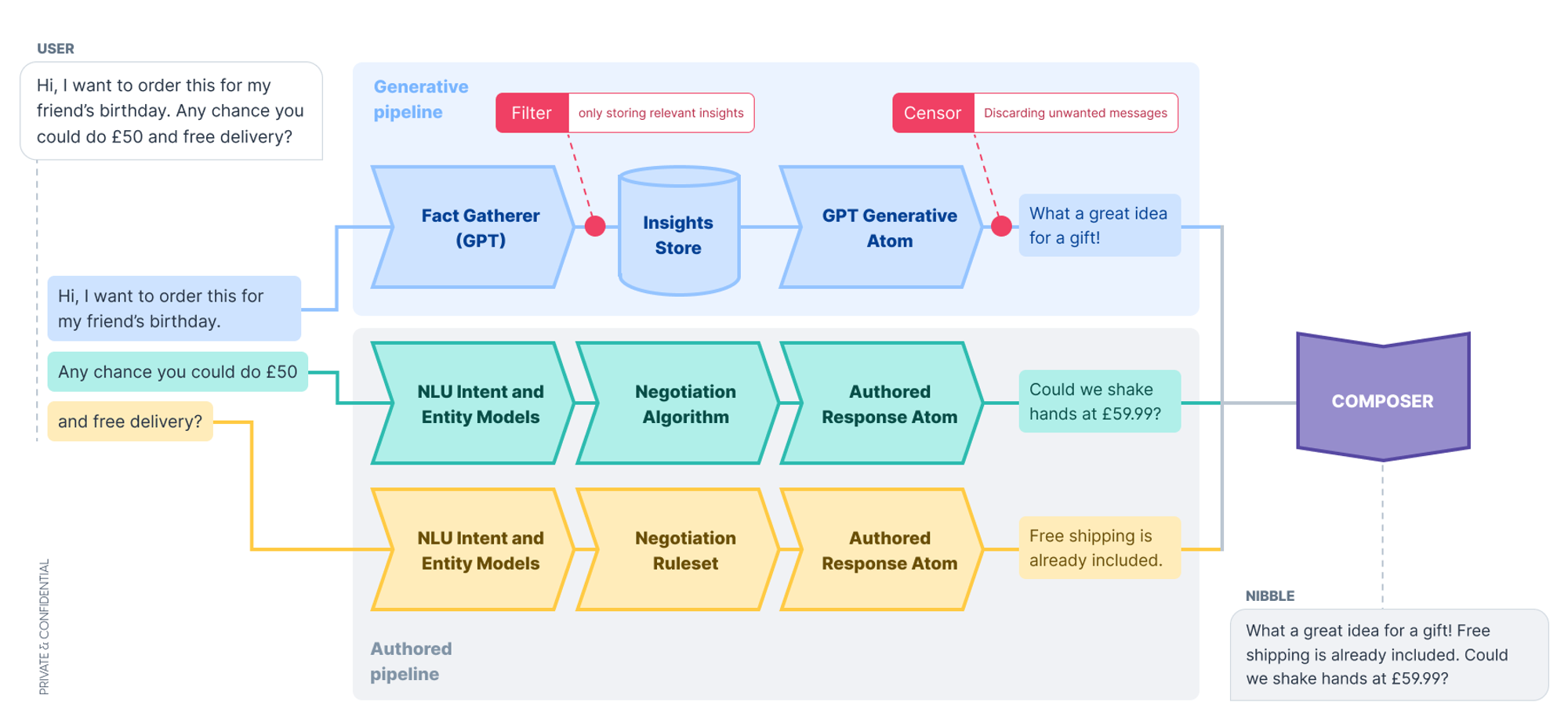From Sam Lunn, CTO at Nibble
Today, I am pleased to announce Nibble’s approach to generative responses – a hybrid method that empowers Nibble to respond to users empathetically while mitigating risks traditionally associated with generative AI.
LLMs offer us a way to respond and engage with users like never before. One of the keys to being a successful negotiator lies in your ability to show the other party you are listening to them and responding appropriately, so leveraging this technology for Nibble is of great interest.
If someone tells Nibble unique information—perhaps that they are going to college next year, buying a gift for their partner, or have a special occasion coming up—being able to acknowledge this helps Nibble engage with the user and improves conversational flow.
First, let’s review Nibble’s traditional approach to responding to user messages.
Atomic Copy
 At Nibble, we have a strict set of requirements for how our bot handles negotiations: it must be as responsive as possible to messages from users; it must maintain a high level of engagement; it must be a good negotiator. Most importantly, it must not make promises it is not authorised to make, and must not respond with messaging unsuitable for the brands it negotiates on behalf of.
At Nibble, we have a strict set of requirements for how our bot handles negotiations: it must be as responsive as possible to messages from users; it must maintain a high level of engagement; it must be a good negotiator. Most importantly, it must not make promises it is not authorised to make, and must not respond with messaging unsuitable for the brands it negotiates on behalf of.
This combination of goals leads us to a text composition system that creates responses to user’s messages using what we call Atomic Copy in three steps:
- We maintain a pool of carefully crafted copywritten ‘Atoms‘. Each atom is an individual phrase that conveys a single concept – for instance, a greeting, a request for an offer, or a response to a loyal customer. Atoms are categorised and deployed based on language, tone of voice, and negotiation context.
- For any particular message, the bot first determines what actions to take and what pieces of information it wishes to impart in its responses.
- The bot then uses a ‘Composer‘ which determines which copy atoms to use, and assembles them into a short response that is returned to the user.
Each atom has several variants that can all fit together like jigsaw puzzle pieces, allowing Nibble to give greater variety in its responses.
This approach ensures that Nibble’s responses are both fast and compliant with our needs. It also allows us to maintain high quality copy in any language without resorting to machine translation.
The limitations of predefined copy
Our atomic copy works great for the vast majority of our chats – the bot understands negotiation concepts very well and we have a wealth of copy atoms covering a large variety of chat scenarios.
Its limit, however, is the same limit that any retrieval-based chatbot reaches: the ‘long tail’ of unexpected and unique user messages. Messages where the user is telling us something that we didn’t predict and haven’t accounted for in our copy atoms. We want to be able to respond appropriately if someone provides unique information – if they are making a purchase for their partner, or have just had good news and want to celebrate with a great deal.
For these messages, Generative AI and LLMs are ideal – they are capable of generating new responses to unexpected messages. But we don’t want an LLM to take over the entire response, as we’ve seen too many examples of hallucinations causing reputational damage, or even promising things the bot shouldn’t be promising – a particularly dangerous outcome for a negotiation chatbot!
Our Solution: Hybrid Atomic Copy

Nibble’s new Hybrid Atomic Copy feature solves the generative dilemma while still producing conversational responses to users’ messages. We do this by adding a small sprinkling of ‘Generative Atoms‘ alongside our prewritten atoms, in a carefully controlled workflow.
Our Generative AI pipeline first gathers insights by prompting an LLM to extract factual information from users’ messages. These insights are carefully categorised and filtered – only insights that are appropriate and relevant to the conversation are kept – and then stored in our Insights Store.
Next, when the bot decides it is appropriate, we choose specific insights and prompt an LLM to generate a very short response to that insight, taking into account the current language and tone of voice — this is a Generative Atom. This atom is then censored for inappropriate content and finally, output alongside prewritten atoms.
The end result is a user-friendly, conversational message that can respond dynamically to unexpected input, but still is primarily composed of carefully managed copy that keeps the negotiation on track and maintains brand values. The LLM has no knowledge or involvement in the actual negotiation, which is still managed by our trusted algorithms and prewritten copy.
Nibble’s Head of Conversation Design, Tim Willers, recently spoke about how Generative Atoms are used in a session at Bentley University. You can watch a clip of this below:
Generative Atoms will be rolling out to select clients from this week.
What next?
You can read some of our customer stories, showing examples of Nibble reducing discounting, increasing margin and conversion rates, and even boosting AOV.
Or, learn about Nibble’s Brand Value Statements that deliver the message your customer or prospect needs to hear at the exact moment they need to hear it to seal the deal.
Interested in Nibble?


